Midea Kitchen Appliances XM262AYY Microwave Oven User Manual W10434160A KCMS2255 UCG
Guangdong Midea Kitchen Appliances Manufacturing Co.,Ltd Microwave Oven W10434160A KCMS2255 UCG
Contents
- 1. VG8XM262AYY_User Manual
- 2. Users Manual
VG8XM262AYY_User Manual
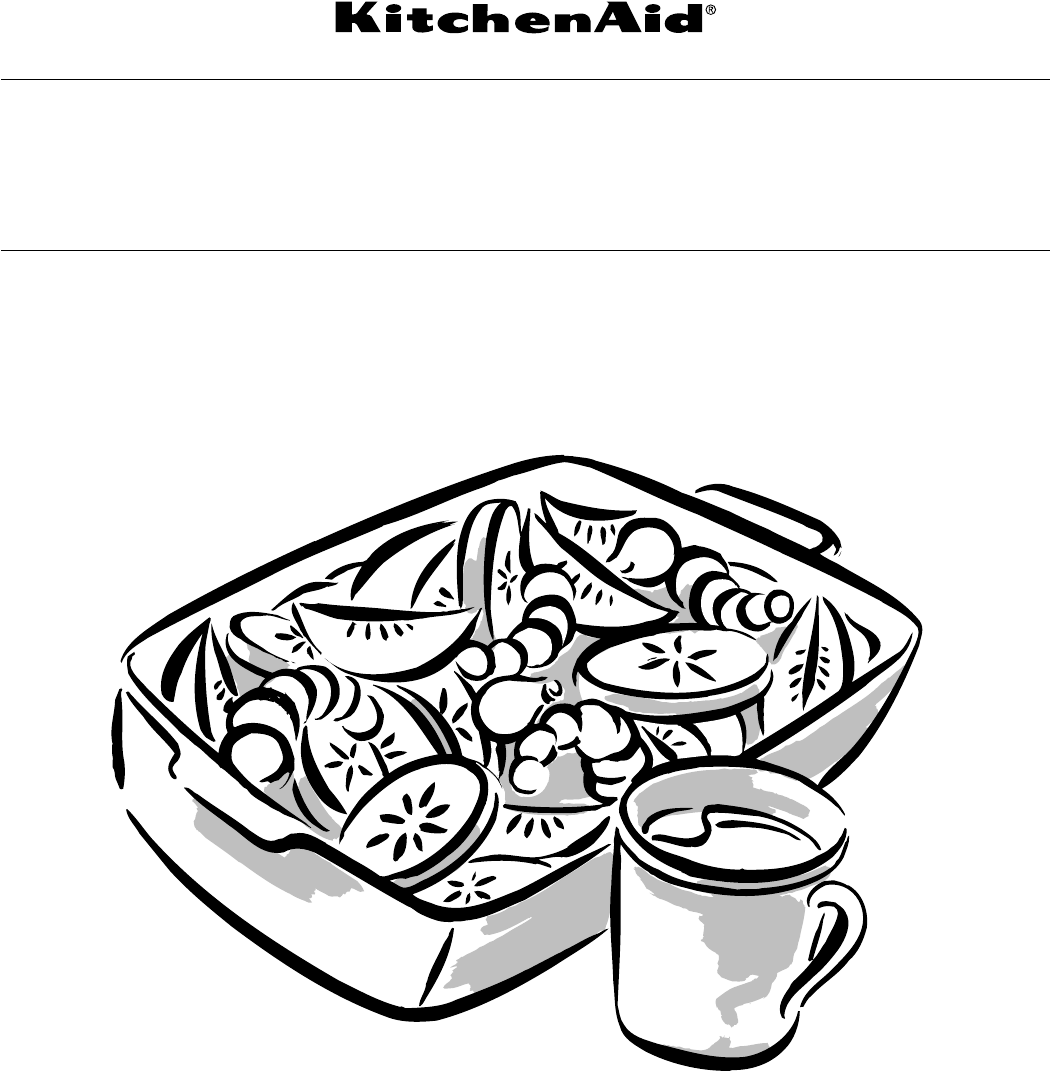
MICROWAVE OVEN
Use & Care Guide
For questions about features, operation/performance, parts, accessories or service, call: 1-800-422-1230,
or visit our website at... www.kitchenaid.com
Table of Contents............................................................................................................2
Model KCMS2255
W10434160A
DRAFT COPY - DO NOT PRINT

2
TABLE OF CONTENTS
MICROWAVE OVEN SAFETY........................................................3
INSTALLATION INSTRUCTIONS..................................................5
Unpacking ....................................................................................5
Location Requirements................................................................5
Electrical Requirements ...............................................................5
PARTS AND FEATURES................................................................6
Turntable ......................................................................................6
MICROWAVE OVEN CONTROL....................................................6
Display..........................................................................................7
Start..............................................................................................7
Add 30 Seconds...........................................................................7
Stop Cancel..................................................................................7
Tones............................................................................................7
Clock ............................................................................................7
Timer.............................................................................................7
Control Lock.................................................................................7
MICROWAVE OVEN USE ..............................................................8
Food Characteristics....................................................................8
Cooking Guidelines......................................................................8
Cookware and Dinnerware ..........................................................9
Aluminum Foil and Metal .............................................................9
Microwave Cooking Power..........................................................9
Manual Cooking .........................................................................10
Cooking in Stages......................................................................10
Favorite.......................................................................................10
Sensor Cooking..........................................................................10
Quick Touch Menu (sensor and non-sensor) ............................11
Weight Defrost / Timed Defrost .................................................12
MICROWAVE OVEN CARE..........................................................13
General Cleaning........................................................................13
TROUBLESHOOTING ..................................................................14
ASSISTANCE OR SERVICE.........................................................15
Replacement Parts.....................................................................15
Built-In Kits.................................................................................15
WARRANTY ..................................................................................15
DRAFT COPY - DO NOT PRINT
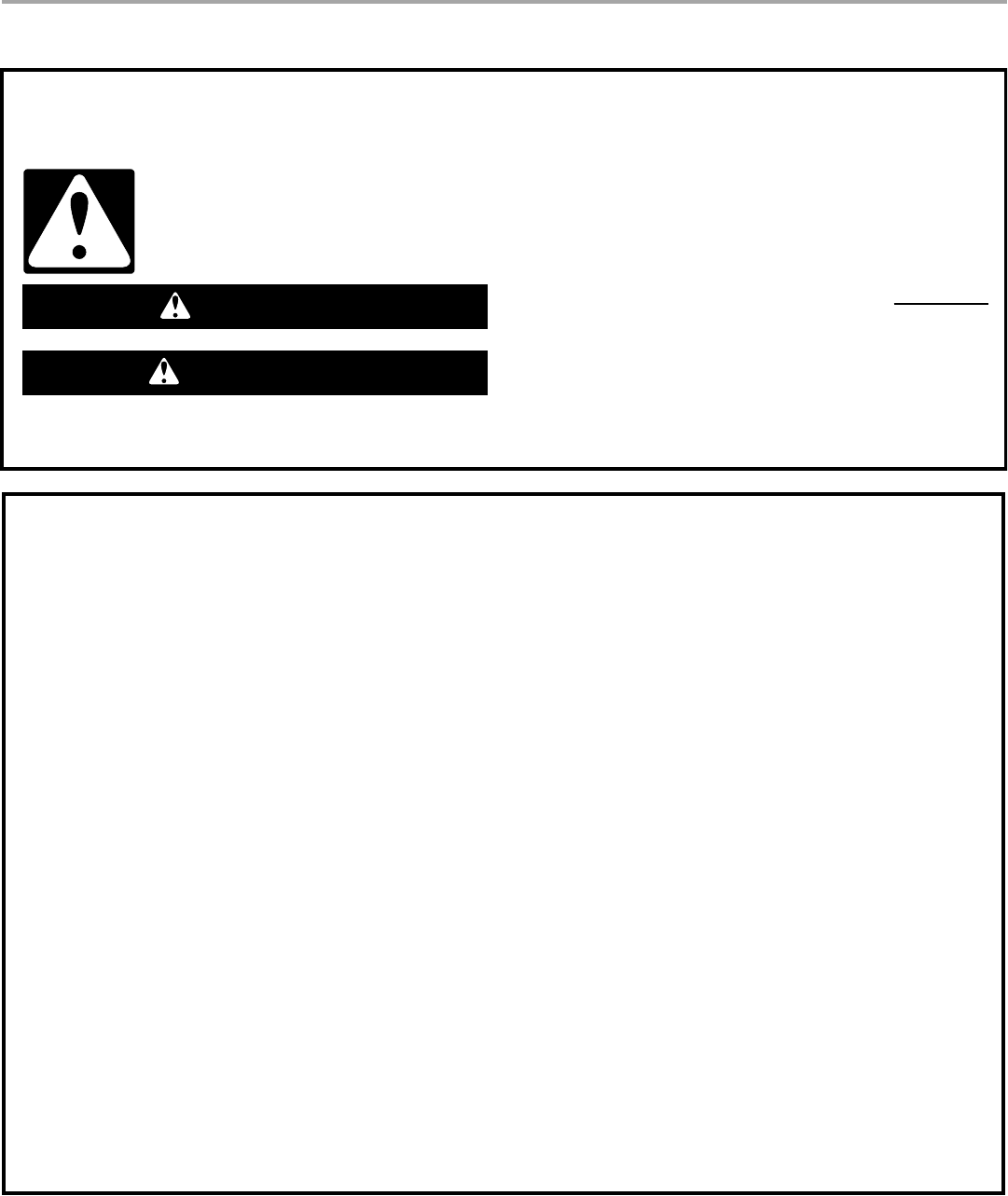
3
MICROWAVE OVEN SAFETY
You can be killed or seriously injured if you don't immediately
You can be killed or seriously injured if you don't follow
All safety messages will tell you what the potential hazard is, tell you how to reduce the chance of injury, and tell you what can
happen if the instructions are not followed.
Your safety and the safety of others are very important.
We have provided many important safety messages in this manual and on your appliance. Always read and obey all safety
messages.
This is the safety alert symbol.
This symbol alerts you to potential hazards that can kill or hurt you and others.
All safety messages will follow the safety alert symbol and either the word “DANGER” or “WARNING.”
These words mean:
follow instructions.
instructions.
DANGER
WARNING
When using electrical appliances basic safety precautions should be followed, including the following:
IMPORTANT SAFETY INSTRUCTIONS
SAVE THESE INSTRUCTIONS
WARNING: To reduce the risk of burns, electric shock,
fire, injury to persons, or exposure to excessive microwave
energy:
■ Read all instructions before using the microwave oven.
■ Read and follow the specific “PRECAUTIONS TO AVOID
POSSIBLE EXPOSURE TO EXCESSIVE MICROWAVE
ENERGY” found in this section.
■ The microwave oven must be grounded. Connect only to
properly grounded outlet. See “GROUNDING
INSTRUCTIONS” found in the “INSTALLATION
INSTRUCTIONS” section.
■ Install or locate the microwave oven only in accordance
with the provided Installation Instructions.
■ Some products such as whole eggs in the shell and
sealed containers - for example, closed glass jars - are
able to explode and should not be heated in the
microwave oven.
■ Use the microwave oven only for its intended use as
described in the manual. Do not use corrosive chemicals
or vapors in the microwave oven. This type of oven is
specifically designed to heat, cook, or dry food. It is not
designed for industrial or laboratory use.
■ As with any appliance, close supervision is necessary
when used by children.
■ Do not operate the microwave oven if it has a damaged
cord or plug, if it is not working properly, or if it has been
damaged or dropped.
■ The microwave oven should be serviced only by qualified
service personnel. Call an authorized service company for
examination, repair, or adjustment.
■ Do not cover or block any openings on the microwave oven.
■ Do not store this microwave oven outdoors. Do not use the
microwave oven near water - for example, near a kitchen
sink, in a wet basement, near a swimming pool, or similar
locations.
■ Do not immerse cord or plug in water.
■ Keep cord away from heated surfaces.
■ Do not let cord hang over edge of table or counter.
■ See door surface cleaning instructions in the “Microwave
Oven Care” section.
■ To reduce the risk of fire in the oven cavity:
– Do not overcook food. Carefully attend the microwave
oven when paper, plastic, or other combustible materials
are placed inside the oven to facilitate cooking.
– Remove wire twist-ties from paper or plastic bags before
placing bags in oven.
– If materials inside the oven ignite, keep oven door closed,
turn oven off, and disconnect the power cord, or shut off
power at the fuse or circuit breaker panel.
– Do not use the cavity for storage purposes. Do not leave
paper products, cooking utensils, or food in the cavity when
not in use.
DRAFT COPY - DO NOT PRINT

4
This device complies with Part 18 of the FCC Rules.
IMPORTANT SAFETY INSTRUCTIONS
SAVE THESE INSTRUCTIONS
■ Liquids, such as water, coffee, or tea are able to be
overheated beyond the boiling point without appearing to
be boiling. Visible bubbling or boiling when the container
is removed from the microwave oven is not always
present. THIS COULD RESULT IN VERY HOT LIQUIDS
SUDDENLY BOILING OVER WHEN THE CONTAINER
IS DISTURBED OR A SPOON OR OTHER UTENSIL IS
INSERTED INTO THE LIQUID.
To reduce the risk of injury to persons:
– Do not overheat the liquid.
– Stir the liquid both before and halfway through heating it.
– Do not use straight-sided containers with narrow necks.
– After heating, allow the container to stand in the microwave
oven for a short time before removing the container.
– Use extreme care when inserting a spoon or other utensil
into the container.
■ Do not mount over a sink.
■ Do not store anything directly on top of the microwave oven
when the microwave oven is in operation.
PRECAUTIONS TO AVOID POSSIBLE EXPOSURE TO
EXCESSIVE MICROWAVE ENERGY
(a) Do not attempt to operate this oven with the door open
since open-door operation can result in harmful exposure
to microwave energy. It is important not to defeat or
tamper with the safety interlocks.
(b) Do not place any object between the oven front face and
the door or allow soil or cleaner residue to accumulate on
sealing surfaces.
(c) Do not operate the oven if it is damaged. It is particularly
important that the oven door close properly and that there
is no damage to the:
(1) Door (bent),
(2) Hinges and latches (broken or loosened),
(3) Door seals and sealing surfaces.
(d) The oven should not be adjusted or repaired by anyone
except properly qualified service personnel.
DRAFT COPY - DO NOT PRINT
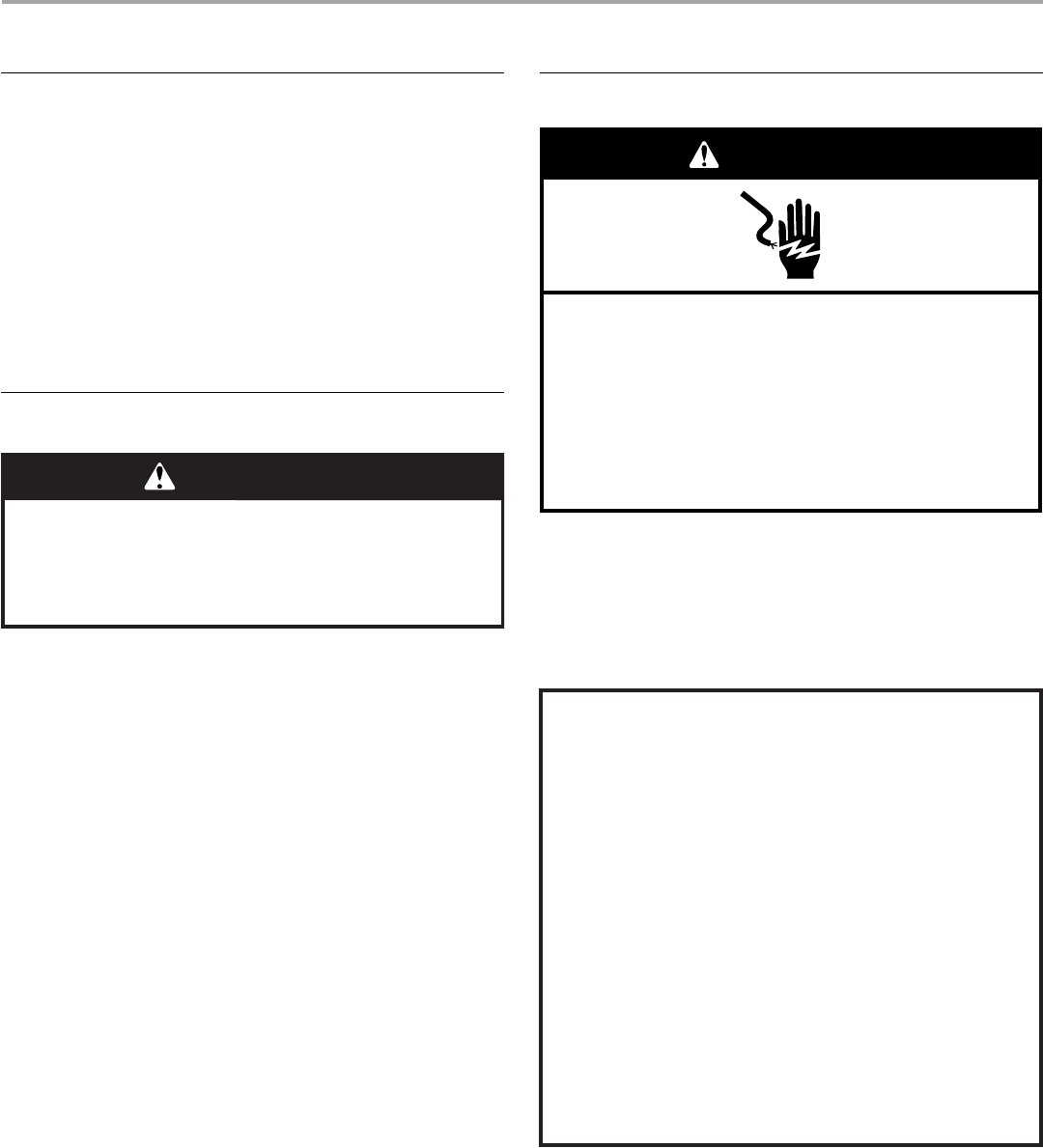
5
INSTALLATION INSTRUCTIONS
Unpacking
1. Empty the microwave oven of any packing materials.
2. Clean the inside with a soft, damp cloth.
3. Check for damage, such as:
■a door that is not lined up correctly
■damage around the door, or
■dents on the interior or exterior of the microwave oven.
If there is any damage, do not operate the microwave oven
until a designated service technician has checked it and
made any needed repairs.
NOTE: To avoid damage to the microwave oven, do not remove
microwave inlet cover. See “Parts and Features.”
Location Requirements
IMPORTANT: The control side of the microwave oven is the
heavy side. Handle the microwave oven gently. The weight of the
microwave oven is over 35 lbs (15.9 kg).
■Place the microwave oven on a cart, counter, table or shelf
that is strong enough to hold the microwave oven and the
food and utensils you place inside it.
■The microwave oven should be at a temperature above 50°F
(10°C) for proper operation.
NOTE: Some models can be built into a wall or cabinet by using
one of the trim kits listed in the “Assistance or Service” section.
■Do not block the exhaust vents or air intake openings. Allow
a few inches of space at the back and side of the microwave
oven where the exhaust vents are located. Blocking the
exhaust vents could cause damage to the microwave oven,
as well as poor cooking results.
■Make sure the microwave oven legs are in place to ensure
proper airflow. If vents are blocked, a sensitive thermal device
may automatically turn the microwave oven off. The
microwave oven should work properly once it has cooled.
Electrical Requirements
Observe all governing codes and ordinances.
Required:
■A 120 volt, 60 Hz, AC only, 15- or 20-amp electrical supply
with a fuse or circuit breaker.
Recommended:
■A time-delay fuse or time-delay circuit breaker.
■A separate circuit serving only this microwave oven.
WARNING
Excessive Weight Hazard
Use two or more people to move and install
microwave oven.
Failure to do so can result in back or other injury.
Electrical Shock Hazard
Plug into a grounded 3 prong outlet.
Do not remove ground prong.
Do not use an adapter.
Do not use an extension cord.
Failure to follow these instructions can result in death,
fire, or electrical shock.
WARNING
GROUNDING INSTRUCTIONS
SAVE THESE INSTRUCTIONS
■ For all cord connected appliances:
The microwave oven must be grounded. In the event of
an electrical short circuit, grounding reduces the risk of
electric shock by providing an escape wire for the electric
current. The microwave oven is equipped with a cord
having a grounding wire with a grounding plug. The plug
must be plugged into an outlet that is properly installed
and grounded.
WARNING: Improper use of the grounding plug can
result in a risk of electric shock. Consult a qualified
electrician or serviceman if the grounding instructions are
not completely understood, or if doubt exists as to whether
the microwave oven is properly grounded.
Do not use an extension cord. If the power supply cord is
too short, have a qualified electrician or serviceman install
an outlet near the microwave oven.
DRAFT COPY - DO NOT PRINT
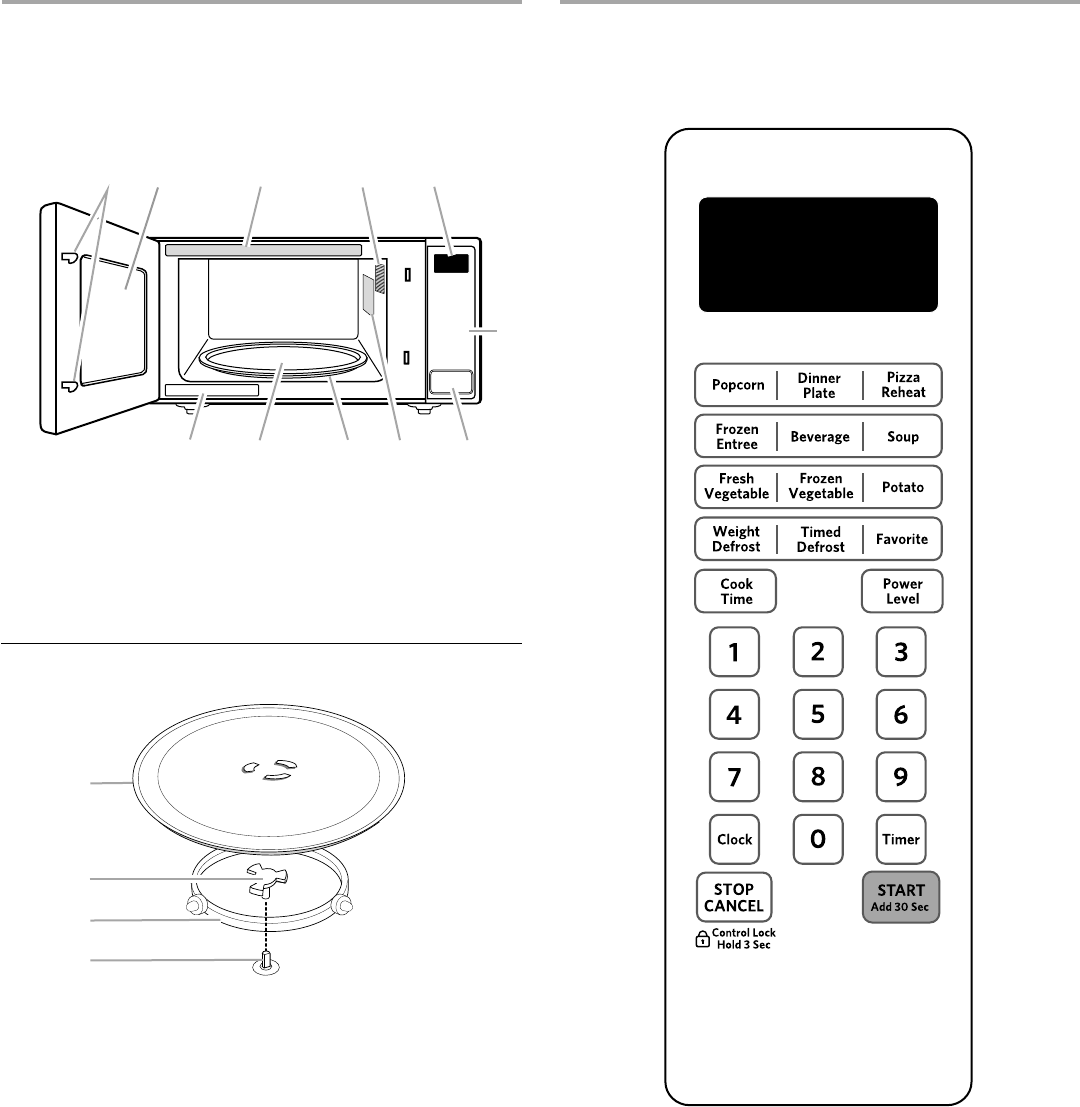
6
PARTS AND FEATURES
This manual may cover several different models. The model you
have purchased may have some or all of the features shown here.
The appearance of your particular model may differ slightly from
the illustrations in this manual.
Turntable
The turntable can rotate in either direction to help cook food
more evenly. For best cooking results, do not operate the
microwave oven without having the turntable in place. See
“Assistance or Service” to reorder any of the parts.
To Install:
1. Place the support on the microwave oven cavity bottom.
2. Place the turntable on the support.
Fit the raised, curved wedges in the center of the turntable
bottom between the three spokes of the hub. The rollers on
the support should fit inside the turntable bottom ridge.
MICROWAVE OVEN
CONTROL
A. Door lock system
B. Window
C. Cooking guide label
D. Microwave oven light
E. Display
F. Con trol p a n e l
G. Door open push button
H. Microwave inlet cover
I. Removable turntable support
J. Glass turntable
K. Model and serial number plate
A. Turntable
B. Hub
C. Support
D. Shaft
A B C D E
K J I H G
F
A
B
C
D
DRAFT COPY - DO NOT PRINT

7
Display
When power is first supplied to the microwave oven, “0:00” will
appear in the display. If the “0:00” appears in the display at any
other time, a power failure has occurred. Reset the clock if
needed. See “Clock.”
When the microwave oven is in use, the display will show cook
time remaining, and the function icons will flash. When the
microwave oven is not in use, the display will show the time of
day (if the clock is set) or Timer countdown (if the Timer is set).
Start
The START control begins any function. If cooking is interrupted
by opening the door, touching START will resume the cycle.
NOTE: To avoid unintentional operation of the microwave oven,
a cooking function cannot be started if the microwave oven door
has been closed for about 5 minutes. The word “door” will
appear in the display until the door is opened and closed.
Add 30 Seconds
The (START) ADD 30 SEC control automatically starts the
microwave oven at 100% power for 30 seconds, and adds
30 seconds of cook time with each additional touch of the
control.
Time may be added to any manual cooking cycle in 30-second
increments, at the current power level, by touching (START) ADD
30 SEC during cooking.
NOTE: To avoid unintentional operation of the microwave oven,
a cooking function cannot be started if the microwave oven door
has been closed for about 5 minutes. The word “door” will
appear in the display until the door is opened and closed.
Stop Cancel
The STOP CANCEL control clears any incorrect command, and
cancels any program during cooking. It will not erase the time of
day.
The microwave oven will also turn off when the door is opened.
Close the door and touch START to resume the cycle.
The STOP CANCEL control is also used to lock and unlock the
control panel. See “Control Lock.”
Tones
Tones are audible signals that can be turned off.
To Turn Off/On All Tones: Touch and hold the number pad 2 for
about 3 seconds. Repeat to turn back on.
To Turn Off/On Reminder Tones Only: Touch and hold number
pad 6 for about 3 seconds. Repeat to turn back on.
These tones indicate the following:
One tone
■Valid entry
■Control lock activated or deactivated
Two tones
■End of stage in multistage cooking
Three tones
■End of Timer countdown
Five tones
■End of cycle
■Reminder, repeat each minute after the end-of-cycle tones
Clock
This is a standard 12-hour clock (12:00-11:59). The Clock cannot
be erased. If the Clock is not set, “0:00” will remain in the display
when the microwave oven is not in use.
To Set:
The microwave oven and Timer must be off.
1. Touch CLOCK.
2. Touch number pads to enter correct time of day.
3. Touch CLOCK.
Timer
The Timer can be set in minutes and seconds, up to 99 minutes
99 seconds, and counts down the set time.
NOTE: The Timer does not start or stop the microwave oven.
Cook functions may be used while the Timer is counting down.
When the cook function is active in the display, touch TIMER to
see the Timer count down for about 5 seconds.
To Set:
1. Touch TIMER.
2. Touch number pads to enter desired time.
3. Touch START.
When the set time ends, “End” will appear in the display and
the end-of-Timer tones will sound.
4. Touch STOP CANCEL while the Timer is active in the display
to cancel the Timer.
The time can be reset during the countdown by canceling Timer,
and then repeating the above steps.
Control Lock
The Control Lock disables the control panel pads to avoid
unintended use of the microwave oven.
To Lock/Unlock Control: The microwave oven must be off.
Touch and hold STOP CANCEL for about 3 seconds, until the
tone sounds and the control lock icon appears in the display.
Repeat to unlock.
If any control pad is touched while the control is locked, there will
be no response from the control.
DRAFT COPY - DO NOT PRINT

8
MICROWAVE OVEN USE
A magnetron in the microwave oven produces microwaves which
reflect off the metal floor, walls and ceiling and pass through the
turntable and appropriate cookware to the food. Microwaves are
attracted to and absorbed by fat, sugar and water molecules in
the food, causing them to move, producing friction and heat
which cooks the food.
■To avoid damage to the microwave oven, do not lean on or
allow children to swing on the microwave oven door.
■To avoid damage to the microwave oven, do not operate
microwave oven when it is empty.
■Baby bottles and baby food jars should not be heated in
microwave oven.
■Clothes, flowers, fruit, herbs, wood, gourds, paper, including
brown paper bags and newspaper, should not be dried in
microwave oven.
■Paraffin wax will not melt in the microwave oven because it
does not absorb microwaves.
■Use oven mitts or pot holders when removing containers from
microwave oven.
■Do not overcook potatoes. At the end of the recommended
cook time, potatoes should be slightly firm. Let potatoes
stand for 5 minutes. They will finish cooking while standing.
■Do not cook or reheat whole eggs inside the shell. Steam
buildup in whole eggs may cause them to burst, requiring
significant cleanup of microwave oven cavity. Cover poached
eggs and allow a standing time.
Food Characteristics
When microwave cooking, the amount, size and shape, starting
temperature, composition and density of the food affect cooking
results.
Amount of Food
The more food heated at once, the longer the cook time needed.
Check for doneness and add small increments of time if
necessary.
Size and Shape
Smaller pieces of food will cook more quickly than larger pieces,
and uniformly shaped foods cook more evenly than irregularly
shaped food.
Starting Temperature
Room temperature foods will heat faster than refrigerated foods,
and refrigerated foods will heat faster than frozen foods.
Composition and Density
Foods high in fat and sugar will reach a higher temperature, and
will heat faster than other foods. Heavy, dense foods, such as
meat and potatoes, require a longer cook time than the same size
of a light, porous food, such as cake.
Cooking Guidelines
Covering
Covering food helps retain moisture, shorten cook time and
reduce spattering. Use the lid supplied with cookware. If a lid is
not available, wax paper, paper towels or plastic wrap approved
for microwave ovens may be used. Plastic wrap should be turned
back at one corner to provide an opening to vent steam.
Condensation on the door and cavity surfaces is normal during
heavy cooking.
Stirring and Turning
Stirring and turning redistribute heat evenly to avoid overcooking
the outer edges of food. Stir from outside to center. If possible,
turn food over from bottom to top.
Arranging
If heating irregularly shaped or different sized foods, arrange the
thinner parts and smaller sized items toward the center. If
cooking several items of the same size and shape, place them in
a ring pattern, leaving the center of the ring empty.
Piercing
Before heating, use a fork or small knife to pierce or prick foods
that have a skin or membrane, such as potatoes, egg yolks,
chicken livers, hot dogs, and sausage. Prick in several places to
allow steam to vent.
Shielding
Use small, flat pieces of aluminum foil to shield the thin pieces of
irregularly shaped foods, bones and foods such as chicken
wings, leg tips and fish tail. See “Aluminum Foil and Metal” first.
Standing Time
Food will continue to cook by the natural conduction of heat even
after the microwave cooking cycle ends. The length of standing
time depends on the volume and density of the food.
DRAFT COPY - DO NOT PRINT
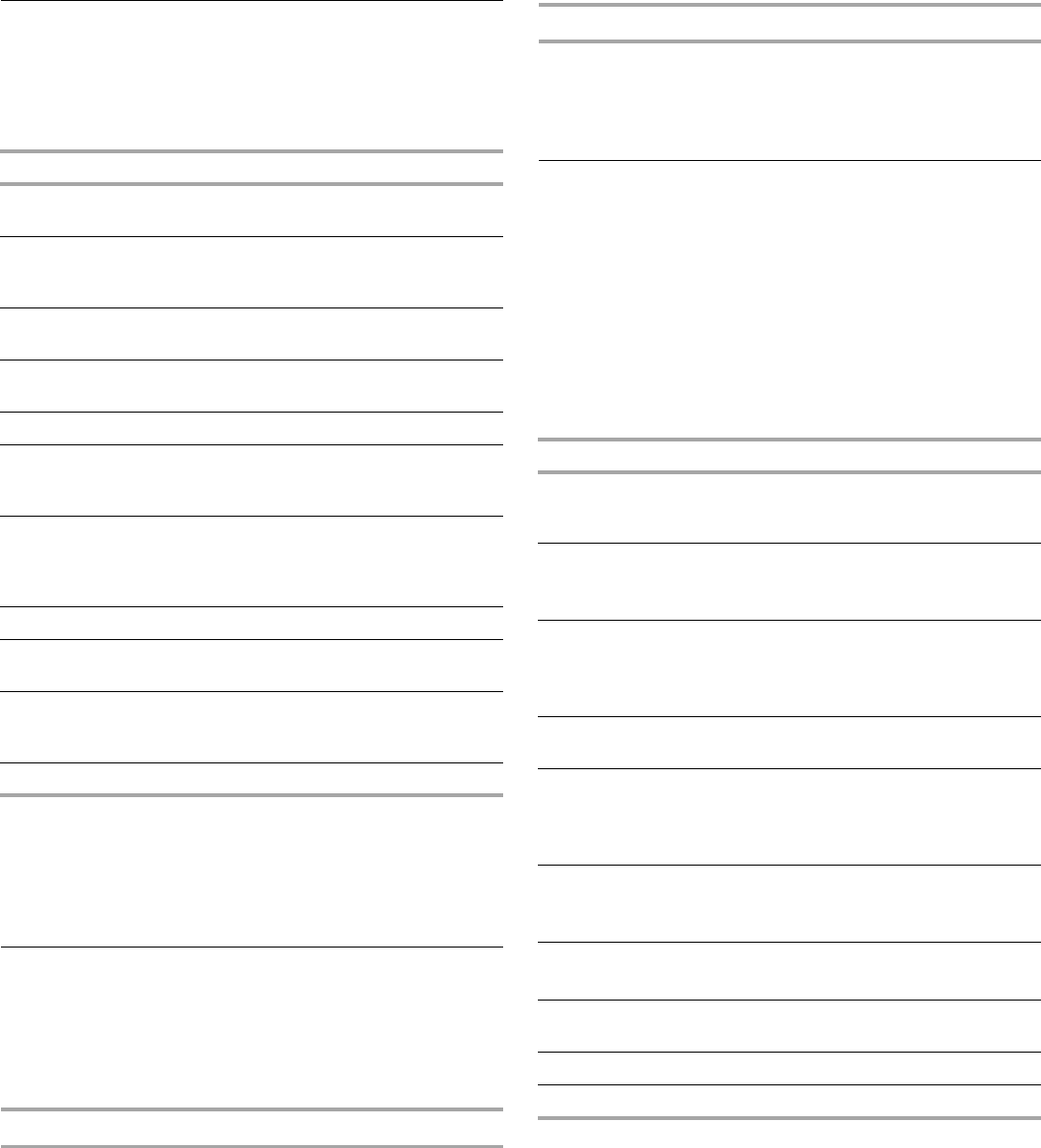
9
Cookware and Dinnerware
Cookware and dinnerware must fit on the turntable. Always use
oven mitts or pot holders when handling because any dish may
become hot from heat transferred from the food. Do not use
cookware and dinnerware with gold or silver trim. Use the
following chart as a guide, then test before using.
To Test Cookware or Dinnerware for Microwave Use:
1. Place cookware or dinnerware in microwave oven with
1 cup (250 mL) of water beside it.
2. Cook at 100% cooking power for 1 minute.
Do not use cookware or dinnerware if it becomes hot and the
water stays cool.
Aluminum Foil and Metal
Always use oven mitts or pot holders when removing dishes from
the microwave oven.
Aluminum foil and some metal can be used in the microwave
oven. If not used properly, arcing (a blue flash of light) can occur
and cause damage to the microwave oven.
OK for Use
Racks and bakeware supplied with the microwave oven (on some
models), aluminum foil for shielding, and approved meat
thermometers may be used with the following guidelines:
■To avoid damage to the microwave oven, do not allow
aluminum foil or metal to touch the inside cavity walls,
ceiling or floor.
■Always use the turntable.
■To avoid damage to the microwave oven, do not allow
contact with another metal object during microwave cooking.
Do Not Use
Metal cookware and bakeware, gold, silver, pewter, non-
approved meat thermometers, skewers, twist ties, foil liners
such as sandwich wrappers, staples and objects with gold or
silver trim or a metallic glaze should not be used in the
microwave oven.
Microwave Cooking Power
Many recipes for microwave cooking specify which cooking
power to use by percent or name. For example, PL7=70%=
Medium-High.
One of the power icons (see “Function Icons” in the “Display”
section) will flash during manual cooking, depending on the
power level of the cycle. To see the exact power level during a
cooking cycle, touch POWER LEVEL. The display will briefly
show the current power level, then will return to the cooking
countdown.
Use the following chart as a general guide for the suggested
cooking power of specific foods.
MATERIAL RECOMMENDATIONS
Aluminum Foil,
Metal See “Aluminum Foil and Metal” section.
Browning Dish Bottom must be at least 3/16" (5 mm)
above the turntable. Follow manufacturer’s
recommendations.
Ceramic Glass,
Glass Acceptable for use.
China,
Earthenware Follow manufacturer’s recommendations.
Melamine Follow manufacturer’s recommendations.
Paper: Towels,
Dinnerware,
Napkins
Use nonrecycled and those approved by
the manufacturer for microwave oven use.
Plastic: Wraps,
Bags, Covers,
Dinnerware,
Containers
Use those approved by the manufacturer
for microwave oven use.
Pottery and Clay Follow manufacturer’s recommendations.
Silicone
Bakeware Follow manufacturer’s recommendations.
Straw, Wicker,
Wooden
Containers
Do not use in microwave oven.
Wax Paper Acceptable for use.
PERCENT/NAME USE
100%, High, PL10
(default setting) Quick heating convenience foods and
foods with high water content, such as
soups, beverages and most vegetables.
90%, PL9 Cooking small, tender pieces of meat,
ground meat, poultry pieces and fish fillets.
Heating cream soups.
80%, PL8 Heating rice, pasta or stirrable casseroles.
Cooking and heating foods that need a
cook power lower than high. For example,
whole fish and meat loaf.
70%, Medium-
High, PL7 Reheating a single serving of food.
60%, PL6 Cooking sensitive foods such as cheese
and egg dishes, pudding and custards.
Cooking non-stirrable casseroles, such as
lasagna.
50%, Medium,
PL5 Cooking ham, whole poultry and pot
roasts.
Simmering stews.
40%, PL4 Melting chocolate.
Heating bread, rolls and pastries.
30%, Medium-
Low, Defrost, PL3 Defrosting bread, fish, meats, poultry and
precooked foods.
20%, PL2 Softening butter, cheese, and ice cream.
10%, Low, PL1 Taking chill out of fruit.
DRAFT COPY - DO NOT PRINT

10
Manual Cooking
NOTE: To cook at 100% power, begin by touching number pads
to enter cook time, then touch START.
To Use:
1. Place food on the turntable and close the door.
2. Touch COOK TIME.
“00:00” will appear in the display. Enter the length of time to
cook.
If cooking with 100% power, skip Step 3.
3. Touch POWER LEVEL.
The default power level PL10 will appear in the display. Enter
the desired power level. See “Microwave Cooking Power.”
4. Touch START.
When the cycle ends, “End” will appear in the display, and the
end-of-cycle tones will sound.
5. Touch STOP CANCEL or open the door to clear the display.
Cooking in Stages
The microwave oven can be set to cook at different cooking
powers for various lengths of time, up to 2 stages, which may
include a defrosting stage. See “Weight Defrost/Timed Defrost”
to set defrosting stage.
NOTE: If a defrosting stage is programmed, it will cycle first.
To Cook in Stages:
1. Place food on the turntable, and close the door.
2. Touch COOK TIME.
“00:00” will appear in the display. Enter the length of time to
cook during the first stage.
3. Touch POWER LEVEL, then enter the desired cooking power
for the first stage. See “Microwave Cooking Power.”
4. Repeat steps 2 and 3 for the second stage.
5. Touch START.
Two tones will sound between stages.
When the cycle ends, “End” will appear in the display, and the
end-of-cycle tones will sound.
6. Touch STOP CANCEL or open the door to clear the display.
Cook time may be added in 30-second increments during the
cycling stage by touching (START) ADD 30 SEC control.
Favorite
Use the FAVORITE control to program, store and recall the top
3 most frequently used manual cook programs. Each Favorite
may have 1 or 2 stages (see “Cooking in Stages” section). In the
event of a power failure, the saved Favorites will have to be
reprogrammed.
To Set FAVORITE:
1. Touch FAVORITE.
“1” will appear in the display. Touch FAVORITE repeatedly to
scroll through “2